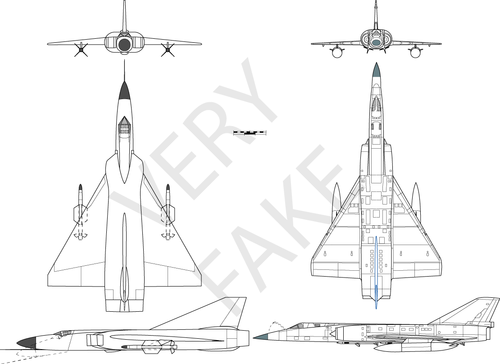I have been wondering if the RAF had adopted the Spey Powered Mirage IVK, could a fighter variant (as was postulated for the TSR2) have been developed. Would the forward fuselage needed to be reconstructed to fit an AI radar and the cockpit canopy be changed to a bubble. Also could the airframe be adapted to carry recessed missiles like the F4 and Tornado ADV.
You are using an out of date browser. It may not display this or other websites correctly.
You should upgrade or use an alternative browser.
You should upgrade or use an alternative browser.
Mirage IVK F1
- Thread starter JohnR
- Start date
Deltafan
ACCESS: Top Secret
- Joined
- 8 May 2006
- Messages
- 1,661
- Reaction score
- 2,120
What JohnR said - congrats, you re-invented the 4000 except a decade before (1968 not 1978)
More seriously: yes, except perhaps for the bubble canopy. There was a lot of space inside a Mirage IV, and the big delta wing had many places were to hangs AAMs. More than on TSR-2, perhaps. Recessed missiles - the undercarriage cinematics might be a PITA.
Also: the recess where the nuclear bomb sat. turn that into a fat belly tank, Lightning style. You could also put a big rocket to boost the climb rate.
In the 60's Ferranti and others were far ahead of Thomson CSF in air to air radars. Missiles - Y2K. R530 was a piece of junk, how good was Firestreak ?
More seriously: yes, except perhaps for the bubble canopy. There was a lot of space inside a Mirage IV, and the big delta wing had many places were to hangs AAMs. More than on TSR-2, perhaps. Recessed missiles - the undercarriage cinematics might be a PITA.
Also: the recess where the nuclear bomb sat. turn that into a fat belly tank, Lightning style. You could also put a big rocket to boost the climb rate.
In the 60's Ferranti and others were far ahead of Thomson CSF in air to air radars. Missiles - Y2K. R530 was a piece of junk, how good was Firestreak ?
- Joined
- 26 May 2011
- Messages
- 2,229
- Reaction score
- 3,158
Thanks gents.
Although I was aware of the Mirage 4000, my train of thought was started by the fighter variant of the TSR2 and layout of the FD3.
Why would there be a problem with fitting a bubble canopy? As I recall in Britain's Lost bomber there was an indication that TSR2 could be fitted with a bubble canopy for a trainer variant.
Although I was aware of the Mirage 4000, my train of thought was started by the fighter variant of the TSR2 and layout of the FD3.
Why would there be a problem with fitting a bubble canopy? As I recall in Britain's Lost bomber there was an indication that TSR2 could be fitted with a bubble canopy for a trainer variant.
Yes it's vaguely possible.I have been wondering if the RAF had adopted the Spey Powered Mirage IVK, could a fighter variant (as was postulated for the TSR2) have been developed. Would the forward fuselage needed to be reconstructed to fit an AI radar and the cockpit canopy be changed to a bubble. Also could the airframe be adapted to carry recessed missiles like the F4 and Tornado ADV.
Yes the whole front from nose point to inlets needs changes.
There was no viable UK SARH AAM in 1968, but the Skyflash was not too far away, so probably Sparrows. Where would you put them?
What about a purchase of or licensed manufacture of AIM-54 Phoenix? Alternatively, perhaps a British variant of the Matra R.530? Yes, it was rubbish but perhaps it could be developed?
Agree with Archibald re a belly tank. Probably also remove the radar from the same area.
Only listing it as an option that theoretically could match the timeline.
Alternatively, perhaps a British variant of the Matra R.530? Yes, it was rubbish but perhaps it could be developed?
Agree with Archibald re a belly tank.
In fact, the Mirage IVA belly tank already existed! 1,600L conformal tank for ferry missions - designation “RS21”:
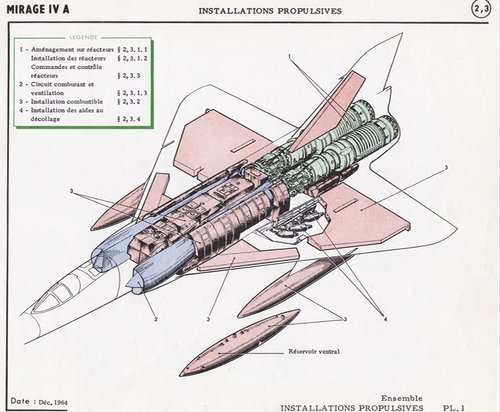
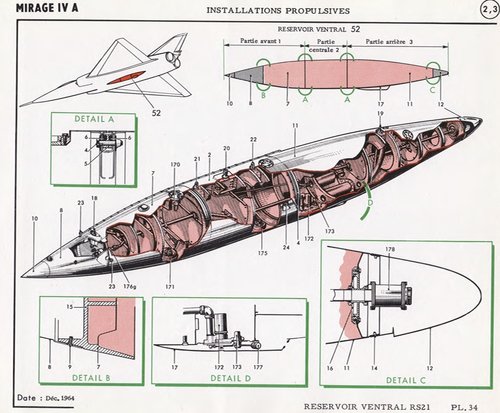
Missiles could be fitted on points 0 (fuselage sides, also used for JATO rockets) or points 2 (outboard wing). These were designed for 400kg bombs:
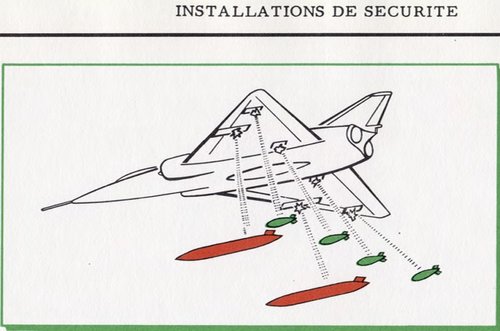
The picture above corresponds to configuration “C” below (bombing).
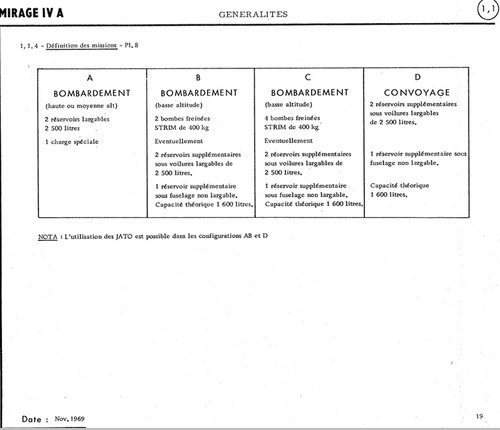
Finally, I disagree that the Matra R530 was crap. It seemed to work OK in its intended mission as a bomber interceptor missile. The RAAF assessed it against the Aim-4 Falcon and Red Top for their Mirage IIIOs and decided it was the more capable missile. Main reasons being the frontal sector capability of the radar version (versus IR) and 2 seeker options. Compared to the Aim-7, it had the benefit of more reliable solid-state electronics, which the Aim-7 didn’t get until the Aim-7F version in the mid-70s. The biggest limitations seem to have been more linked to the weaknesses of the Cyrano radar, ie. lack of look-down shoot down capability etc.
Last edited:
So a few options.
Mid 50's start.
RB.106, AI.18, and Red Hebe.
Post '57 to 1966 start.
OR.346 systems. Which eventually became FMICW (not Foxhunter) and the various offerings of a missile that saw the A5 seeker work in the 60's.
Various variations of Spey or Medway.
Or Olympus OL.22R.
Interim solutions.
AI.23 developments and Radar Red Top possiblywithanew motor, and developed Avons.
If you want a real wildcard engine then a scaled straight through version of the Pegasus.
Mid 50's start.
RB.106, AI.18, and Red Hebe.
Post '57 to 1966 start.
OR.346 systems. Which eventually became FMICW (not Foxhunter) and the various offerings of a missile that saw the A5 seeker work in the 60's.
Various variations of Spey or Medway.
Or Olympus OL.22R.
Interim solutions.
AI.23 developments and Radar Red Top possiblywithanew motor, and developed Avons.
If you want a real wildcard engine then a scaled straight through version of the Pegasus.
To add to my previous post, here is a rare picture of the RS-21 belly tank:

 spotaero.blogspot.com
spotaero.blogspot.com


Les caractéristiques & équipements du Mirage IV A (partie 3/5)
Les caractéristiques, équipements et livrées du Mirage IV A

Fair comments re the R.530 and when you think about it, the AIM-7 didn't exactly have a stellar record during the same era. Getting back to the scenario at hand, a Mirage IV interceptor with say 4 missiles (2 x IR homing and 2 x SARH) would be an interesting 'Soviet style' heavy interceptor.
kaiserd
I really should change my personal text
- Joined
- 25 October 2013
- Messages
- 1,665
- Reaction score
- 1,702
Not sure of the precise timing of this theoretical proposed Mirage IV based interceptor (1968 - end of real-world production, doesn’t appear to tally with, for example, any relevant UK procurement decisions).
In addition the big Mirage doesn’t appear to line up to be a F-4 alternative (probably longer ranged but really too late, inferior systems and weapons, a bit too much aircraft for most fighter tasks and lacking versatility re: different fighter roles), and too early, too thirsty and not nearly capable enough to be a proto-Tornado F3 (far too much tanker support needed, etc.)
As for the likes of Israel and many others, etc. US military aid paid for the real world F-4s.
As an alternative TSR-2 it is more credible but hard to see many customers given how few contemporaries like the F-111, A-5 or even the likes of the Buccaneer, etc. were sold beyond their home countries.
In addition the big Mirage doesn’t appear to line up to be a F-4 alternative (probably longer ranged but really too late, inferior systems and weapons, a bit too much aircraft for most fighter tasks and lacking versatility re: different fighter roles), and too early, too thirsty and not nearly capable enough to be a proto-Tornado F3 (far too much tanker support needed, etc.)
As for the likes of Israel and many others, etc. US military aid paid for the real world F-4s.
As an alternative TSR-2 it is more credible but hard to see many customers given how few contemporaries like the F-111, A-5 or even the likes of the Buccaneer, etc. were sold beyond their home countries.
I understood that Dassault and British Aircraft Corporation (BAC) proposed a modified Mirage IV variant as a TSR.2 replacement in July 1965 so that would be the approximate timings I would imagine.
- Joined
- 6 September 2006
- Messages
- 4,623
- Reaction score
- 8,612
If we are talking late 1960s then M. Dassault has a whole host of delta and VG winged goodies for the RAF brass to drool over.
The Mirage IV probably wouldn't be the prime offering by then, the F and G series offer far more going forward. For the early 60s though the original Mirage IV would have been a contender.
Chris' drawing of the 'Delta III' and Mirage IV is again very instructive. Time and again British designers seem to come up with something more massive that it needs to be. Perhaps British aircraft were fed on Weetabix?
The Mirage IV probably wouldn't be the prime offering by then, the F and G series offer far more going forward. For the early 60s though the original Mirage IV would have been a contender.
Chris' drawing of the 'Delta III' and Mirage IV is again very instructive. Time and again British designers seem to come up with something more massive that it needs to be. Perhaps British aircraft were fed on Weetabix?
the big Mirage doesn’t appear to line up to be a F-4 alternative (probably longer ranged but really too late, inferior systems and weapons, a bit too much aircraft for most fighter tasks and lacking versatility re: different fighter roles), and too early, too thirsty and not nearly capable enough to be a proto-Tornado F3 (far too much tanker support needed, etc.)
The Mirage IV isn’t as big as it looks - in the same weight class as a Super Hornet, F-15E or Mirage 4000, and same size class as a YF-23 or Su-57 (but lighter). So even if not as maneuverable, it would be fine as an interceptor.
The main problem was the avionics... stick UK systems in there and problem solved. And the thirsty Atar engines... stick a pair of Speys and problem solved. Additionally this would greatly reduce runway length requirements.
Only way this could happen in real life IMHO is starting with the RAAF strike competition in 1963. If Dassault could have offered a Spey Mirage IVO it would have been a lot more competitive. (The RAAF evaluation scored the RA-5C Vigilante highest, with the paper TFX and TSR2 also being ranked highly despite late delivery schedules and associated program risk)
If the RAAF picks the IVO with UK engine and avionics for strike, then the IVK becomes a lot more compelling for the RAF. If the RN loses the inter-service funding battles then the money for the F-4K and Ark Royal’s Phantomization becomes available for the RAF to build a long-ranged strike/interceptor. If the TSR-2’s engine problems and TFX delays continue, then the IVK could sneak in as a low-risk option.
Lot of ifs...
Mirage IV was part of the Heavy Fighter studies by Dassault. Marcel himself was not that enthusiastic to turn this into a Medium Bomber, as he felt the fighter had considerable attractions.
So it's actually not impossible he'd jump on a UK deal for a fighter version.
This all being around the time of the Sandystorm.
It's also clear that such a deal if it came with guarantees or licences for a UK engine could resolve some of the issues with the Mirage IV.
Potential for the mother of all spats as Hawkers was pushing the P1121 at this time.
On Dassault's side is ironically, the Medium Bomber designation.
So it's actually not impossible he'd jump on a UK deal for a fighter version.
This all being around the time of the Sandystorm.
It's also clear that such a deal if it came with guarantees or licences for a UK engine could resolve some of the issues with the Mirage IV.
Potential for the mother of all spats as Hawkers was pushing the P1121 at this time.
On Dassault's side is ironically, the Medium Bomber designation.
Last edited:
- Joined
- 27 March 2006
- Messages
- 1,842
- Reaction score
- 1,520
Does anyone know what g limits the Mirage IV airframe was rated to?
Not a lot of info out there but 4g seems to have been the operational limit when heavy and 6.5g was possible lightly loaded… not sure those are absolute limits though.Does anyone know what g limits the Mirage IV airframe was rated to?
Perhaps a really dumb question, but would sticking in something like a Olympus 301 in an airframe similiar to the Mirage IV have allowed the design to supercruise? Its a slightly larger engine (113 vs. 100cm, 1850 vs 1550 kg) that requires quite a bit more airflow, but OTOH even a de-rated Mk301 has more dry thrust than a wet Atar (80kN vs. 70kN).
Similar threads
-
FLIGHTS OF FANTASY: What if the Spey-powered Mirage IVK went into production?
- Started by Sentinel Chicken
- Replies: 18
-
-
Anglo-French RR Spey timeline
- Started by Archibald
- Replies: 116
-
"Red Card" a British SARH AAM GDA.103/AST.1193
- Started by zen
- Replies: 0
-


